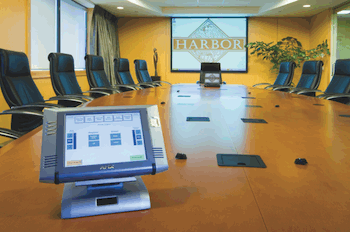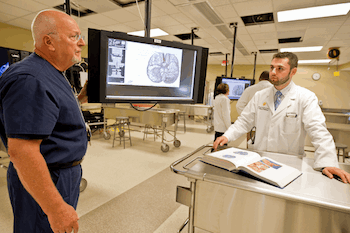It’s just like any marriage: When two entities merge, the rules change. In the enterprise environment, created by the merging of AV and IT, the final parameters may still be blowin’ in the wind, but savvy integrators and consultants should be actively positioning themselves on the playing field.

- Harbor Distributing of Anaheim, CA deployed AMX solutions for consistent, reliable, and scalable AV systems in the boardroom, hospitality, and training rooms throughout its headquarter campus.
- “We understand by now that the emerging enterprise IT consumer has research and purchasing behaviors that are quite different than end-users experienced in sourcing systems using traditional AV personnel,” said Steve Metzger, president and CEO of Biamp Systems. “The marketplace is changing as these emerging customers grow in number and turn to supply chains familiar to them as a source for products and services.”
- These new decision makers and suppliers place a different value on the product and services mix than those in the traditional AV channel. “These developments require that companies retool their thinking and consider new approaches to everything from product development to support services,” he continued. “This current period of transition offers enormous opportunity to forward-thinking companies, whether they are manufacturers, consultants, or integrators, and are willing to recognize the change taking place. The new rules for doing business are in flux and will continue to evolve as the market shifts and matures. The key for a company to successfully navigate the transition is to recognize that this change is inevitable and embrace it.”
- AMX codifies the merger with a number of values that IT appreciates and which the AV community will have to learn to appreciate in order to make solutions friendlier for an IT shop, said Joe Andrulis, vice president of global marketing at AMX. These main values are: Network Centric—components and tools must adhere to IT expectations; Open Standards—avoiding proprietary implementations and protocols; Scalable—so that management tools support server farms for global deployments; Reliable—with high availability and rapid break-fix support tools; Centrally Managed—so that tools are accessible globally for follow-the-sun support; Secure—with LDAP integration for access control.
- “These are all components inherent in IT systems and are familiar to IT people,” Andrulis explained. “But they are not always the same values that drive the AV community, which has been more insistent on delivering the utmost performance possible, even if the standard was not utilized or other values had to be foregone. The IT world is a world of ‘good enough to get the job done.’ So there needs to be a shifting of priorities from performance to usability and maintainability.”
- If there is a big winner, it’s the networking world, said Steve Lampen, multimedia technology manager at Belden. “Networking as an entity, as a way of hooking devices up, is going to win. It’s an elegant way of making many connections between many devices. The problem has been that the way networking has been configured since its inception never lent itself to the AV world. It was used sparingly and awkwardly, with many proprietary solutions, and that is changing rapidly, although a lot of organizations outside of IEEE (which originates the ethernet standard) are fighting it or coming out with their own solutions. P802.1BA AVB (Audio Video Bridging) is a rewrite of the entire ethernet standard to include AV and all the bells and whistles necessary for those applications.”
- Energizing the Energy
- In a world increasingly concerned with energy consumption, remote management solutions continue to encompass new tasks. And although AV objectives haven’t changed much, the delivery has, said Andrulis. “Because energy management is usually integrated with building management, the BMS (Building Management System) is important. To manage energy, the BMS worries about lighting and environmentals, such as HVAC, among other systems. Part of the AV experience is dependent on environmental settings and lighting as well. Increasingly, AV systems need to work cooperatively with the BMS to ensure that both systems get their jobs done effectively.”
- Separately, the proliferation of portable and personal smart devices is removing the place-centric nature of AV and making it more person-centric. “We have to devise a view of what the AV experience will look like in such a way that people can move into and out of a place, such as a conference room, seamlessly,” Andrulis said.
- From the AV standpoint, there aren’t many new tasks to be done, but they will be done using tools that were proprietary—tools that manufacturers built on their own, Lampen said. “The problem is that elegant solutions do not mean that box A will talk to box B. Now there will be a standard, so every device will plug into every other device. Networking is much more energy efficient than the standard AV style of signal processing, but that’s a minor savings compared to the labor and configuration savings.”
At the University of Central Florida College of Medicine in Orlando, FL, the anatomy lab features ceiling mounted computer terminals so students can access anatomical information during dissection. Crestron DigitalMedia distributes the content throughout the facility to other classrooms.
Global enterprise organizations have hundreds, if not thousands, of standardized conference and training rooms with AV systems. “But those control processors are not providing as much value for the owner as they could,” said David Wilts, director of integrated building technology at Crestron. “By tying the processor to the mechanical, lighting, and shade systems, as well as to the occupant calendar application, a new type of dynamic automation may be enabled. This dynamic automation would be very cost-prohibitive, if not impossible, with a traditional BMS.”
There needs to be an occupancy sensor in every conference room, but not just to turn the lights on and off; that’s a waste of the owner’s money, he continued. “The sensor should be shared with the AV system, mechanical system, shade control, and, most importantly, the occupant’s calendar application such as Outlook. By sharing the status with multiple systems, you increase room utilization. Microsoft has done that in every conference room with Crestron’s Fusion RoomView management application. If no one shows up in a space within five minutes of a scheduled meeting, the room becomes available again in the calendar. At Microsoft, room utilization went from 65-percent to over 90-percent through this type of integration.”
For integrators, the market opportunities are expanding. “If the corporations tried to automate every space using a typical building management system, costs would be exorbitant,” Wilts said. “AV contractors are so well positioned to capture this market segment, especially when you look at how enterprise corporations standardize on a single processor firm-wide. There’s a ton of easy automation that could be implemented. It’s low hanging fruit.”
Category cable is the clear frontrunner in this new landscape. “Cat-6 is the way to go,” Wilts suggested. “It is ubiquitous in the enterprise market and the more the AV industry can embrace the cabling IT is utilizing, the better. All of the AV-specific cabling requirements are nearing their end-of-life.”
The move toward standardized cabling is part of the overall movement toward standards. “For IT, the preference is Cat cabling,” Andrulis agreed. “AV systems are already available that use Cat cabling for control and media distribution. This is likely to continue and eventually evolve to use the IP data transmission protocols as well, thereby fully integrating AV with the IT infrastructure.”
The whole point, Lampen said, is that the move into the networking world is akin to jumping into a huge flowing river. “You become part of that river of data and therefore you can use all the architecture which makes that so efficient. Those expensive specialty devices for audio and video professionals will now become standard networking equipment.
“There is efficiency a lot don’t see, and to add AVB to ethernet means that virtually every device out there will have a little AVB sticker on it and will be able to be used by those who are not traditional networking managers, such as broadcasters,” he said.
“It’s going to personalize a lot of things we have been told can only be done in a giant building with a million dollars’ worth of devices. Changing over to a networking device is cheap by comparison. There is a magnitude of cost savings once you jump into that river. The only problem is that it’s clear everyone’s going in this direction, so all these other alternate standards are halfway jumping in and saying they’re going to create their own standard.”
